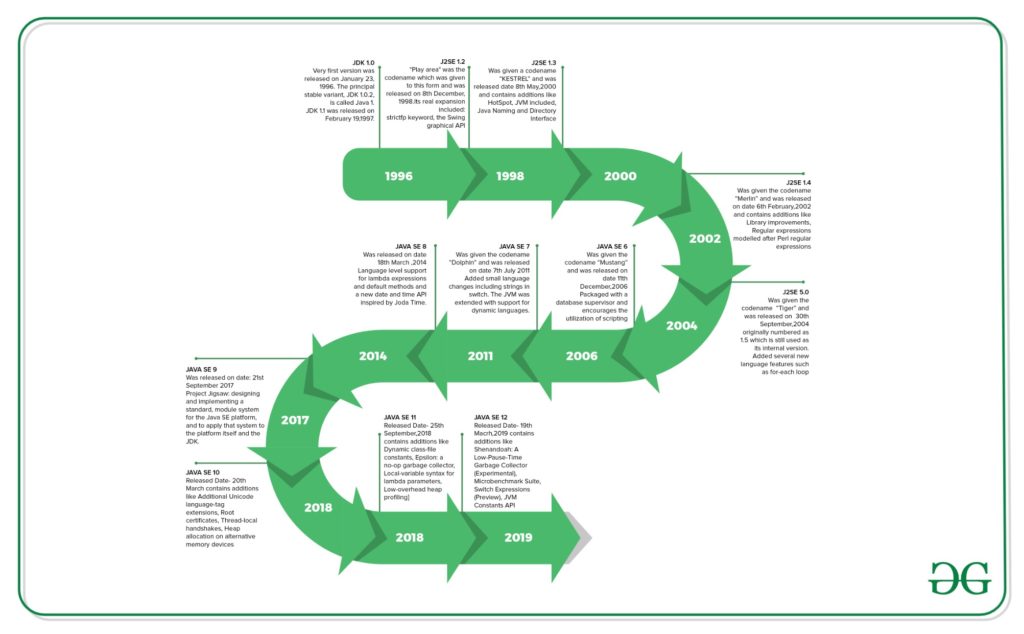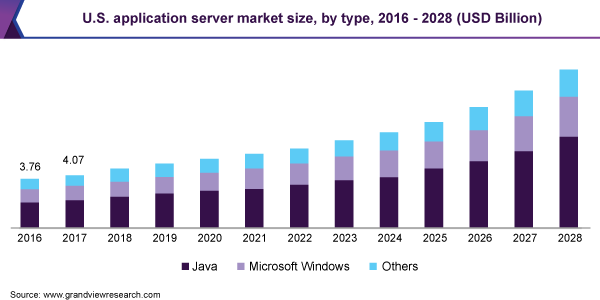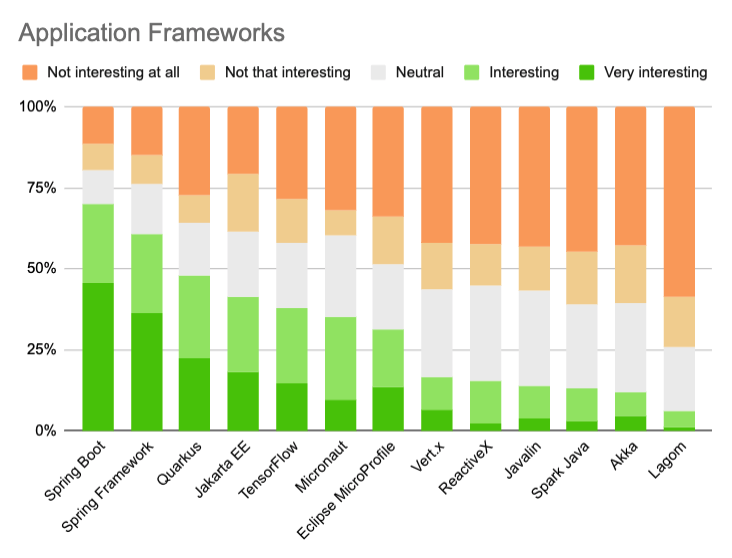Java is ruling the enterprise application development market despite the emergence of numerous similar coding frameworks over the past few years.
If you’re looking for incredibly scalable, flexible, and secure enterprise software development platform, you must consider Java. But wait, you must be wondering, “Why Java?” What makes the programming language superior to others?
Well, no single aspect is responsible for its timeless dominance in the software development landscape. Instead, its legacy has long relied on an array of programming-related advantages. Let’s understand why Java development is continually winning in the enterprise software arena.
Dominating the Enterprise Software Development Landscape
Analysts and developers alike have log preferred Java for building scalable enterprise software applications development. Native Java compilation makes it cheaper. Moreover, it creates applications that start much faster and use less memory.
- Java 17 and Java 18 are the latest versions of Java programming languages.
- Moreover, older but still supported and improved versions are Java 7, Java 8, and Java 11, which will be upgraded to 7u341, 8u331, and 11.0.15.
- Also, you must know that you can install multiple versions of it simultaneously with the Java Development Kit (JDK) or the Java Runtime Environment (JRE).
All of these contribute to Java’s dominance in 2022, causing every enterprise development company to leverage its potential.
Furthermore, its evolution is also a major catalyst behind its popularity and widespread enterprise adoption.
Evolution of Java in 25 Years
Java came to being as an object-oriented programming language that James Gosling developed in his lab, in the early 1990s. The team launched this project to develop a language for digital devices such as receivers, televisions, and many more.
The team originally thought to use C ++ in the project, but later rejected it for various reasons (such as C++ requires more memory).
Gosling tried to change and expand C ++ but soon stopped, performing another step called Green. Later Gosling and his team dubbed the project as “Greenall” and introduced it with file extension .gt and later renamed it “OAK”.
Java relies on wide-ranging principles such as robust, portable, platform-independent, high-performance, multi-threaded, etc.
In 1992, Java became a well-known language for its usefulness on portable and handheld devices such as pagers, cell phones, and so on. By the end of 1992, Java was becoming very popular on the Internet for creating graphics applications and games.
Later, Sun Microsystems recreated Java, and Oracle in 2009 acquired it. Today, Java builds are available as a patented option in Oracle and as an open-source build called OpenJDK.
The open-source approach helps to improve the code and allows for more development and bug fixes than a single organization can do with limited resources.
As a result, if you hire Java developers, they can rapidly develop and release code, especially after the transition to the new release model. Moreover, Long-term support versions are provided every two years.
Popularity That Drives Enterprise Adoption
Java gained huge popularity in the very beginning due to its own run-time environment Java Virtual Machine (JVM) that grew year by year. Presently, Java is a crucial part of small applications and large enterprise-wide solutions.
Furthermore, unlike other programming languages around the world, whose role has lengthened over time, Java has become increasingly powerful with each recent update.
According to the TIOBE index, Java is still one of the most popular application programming languages. Another report from Statista shows that in early 2022 Java is among the 5 most used programming languages in the world.
Here are some crucial facts that prove the victory of Java.
- 45+ Billion active java virtual machines, globally.
- 41% of microservices developers in 2022 are using Java.
- 25+ Billion active java cloud virtual machines.
- Java enables DevOps, AI, Big Data, VR, Mobile Apps, Chatbot development, and more.
Agility, reliability, and vast expertise are major aspects behind its global popularity. Altogether, the experience that programmers gather in writing most lines of code in Java over the past quarter of a century.
All of these cause a huge trust of enterprises in Java and incredible popularity in the market. Also, Java has the ability to keep up with the modern world and respond quickly to unprecedented changes. It also helps to make the most of the trends in modern technology.
Java Tools & Frameworks Backing Enterprise Development
A variety of tools enriches the Java ecosystem, created especially for Java fans and enterprise projects. For example, the significant improvement in performance and efficiency of native image applications.
Moreover, microservices have reduced RAM costs and increased the scalability of complex applications.
Java ecosystem frameworks allow for easier development of certain applications, including Spring Boot, Quarkus, Micronaut, and many more.
Moreover, Java platform enhancements in recent years include lambda, type tracking, pattern matching, and records. These innovations have brought the language syntax closer to its competitors in terms of convenience, while maintaining security.
Presently, it is a powerful yet statistically typed language – while still allowing for the most productive runtime environment, in industry use.
The modern approach is always the strongest area of the Java community. As a result of ongoing work, Java remains an essential choice for developing robust, scalable, and multi-layered applications for any business need.
So, connect with an expert Java development company to bring the most out of it in enterprise development.
Ongoing Initiatives to Make Java Even Better
Several important initiatives are currently underway to build a Java platform and environment.
- Panama Project: The project aims to make Java more compatible with libraries written in other languages.
- The Loom Project: It reinforces multi-threaded operation.
- The Amber Project: It focuses on modifying Java code to increase developer productivity; many other projects.
Choosing a major programming language can be a challenge–especially for enterprise development. In addition, some experienced programmers may joke that we use any language (whether C #, C ++, JavaScript, Java, or Python), each in its own way.
Why is Java Always the No. 1 Choice for Enterprise Application Development?
Here are some critical reasons.
#1. Stability
For stability, it is the default programming language for some of the largest companies in the world. It is an authentic and reliable technology that businesses choose for their web applications.
That’s why more businesses are relying on the power of language to create enterprise applications. Companies needed a stronger development solution for their unstructured infrastructure to act as a unifying element in software technology.
The precise answer to this requirement was the independent environment that only Java offers, including platforms and scalable capabilities.
Today, most companies prefer to adhere to Java because it simply works. Language is now an integral part of most IT infrastructure systems, and it is simply not worth the hassle of replacing something else with negligible advantages.
#2. A vast range of libraries
Java experts appreciate the large number of libraries provided by the technology. It allows developers to easily solve the most common problems. Most libraries offer a free, open-source, and enterprising license.
You do not have to write everything from scratch – there is a library for that. If you want to develop any enterprise application, you probably will not find one, but many comprehensive Java libraries that have everything you need to get things done.
Enterprise needs have specifically been kept in mind while designing Java libraries.
They solve the problems faced by Java developers during enterprise application development. In addition, these libraries are free, open-source, and offer cost-effective licenses to start using them immediately.
#3. Scalability
Scalability is key to enterprise application success. Without proper support, enterprise software development can become very inefficient very quickly. Besides, Java helps enterprises achieve agile software development goals for digital transformation.
The enterprise-level workload was the center of attention throughout the Java development endeavor.
Similarly, Java works very well with Hadoop, a very popular open-source platform for reliable, scalable, and distributed computing. Hadoop pioneers also accidentally wrote it in Java.
Currently, plenty of companies use Hadoop to manage Big Data applications. Also, it is easier to integrate operations with data-driven decisions. Actually, Java runs on any modern hardware and eradicates technical dependency.
It also makes it less expensive for Java software companies to set up, maintain and connect all the devices and operating systems (Windows, Mac, mobile devices, etc.) that can be used within the company.
Wrapping Up
All the features in Java enable developers to increase application efficiency, save time for developers, speed up production cycle time, reduce development costs, and improve language usability.
However, bugs are still common in new Java software. But commonplace development and open-source approaches play an important role in identifying and resolving these issues efficiently and quickly.
A strong community of Java developers and companies is working to create a better Java environment. Updates in Java make it one of the most popular coding languages and the best choice for building enterprise applications.
FAQs
Q. What is the difference between web applications & enterprise applications?
A web application executes in a web-container and comprises servlets alone and named with an extension. Whereas an enterprise application runs in a special container called enterprise container which has special features like JMS, Transaction, etc. Java India offers industry-best web and enterprise application development services.
Q. What is Java programming used for?
Java is a widely used general-purpose programming language. Java is designed for use in the distributed environment of the internet. It is the most used for Android mobile apps. Java is also extensively used for developing enterprise software applications development .
Q. How much does it cost to build a Java enterprise application?
The costs of developing a Java enterprise application depend on several factors. Design complexity, development time, type of features, etc. play an important role in calculating the costs. Java India delivers impeccable Java enterprise applications at a competitive price.


























